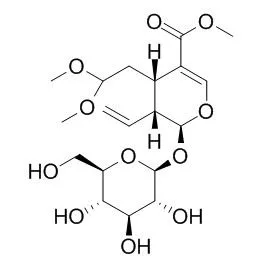Previously, we have reported that geniposide isolated from an extract of Gardenia fructus has neuritogenic activity in PC12h cells, a subclone of rat pheochromocytoma cells. Furthermore, we have indicated that several geniposide-related iridoid compounds also had similar potent neuritogenic activity.
METHODS AND RESULTS:
In this study, we have examined the effects of various secoiridoid compounds [K-1, sweroside; K-2, swertiamarin; K-3, gentiopicroside; K-4, 6'-O-β-D: -glucopyranosylsweroside; K-5, 6'-O-β-D: -glucopyranosylgentiopicroside; K-6, 6'-O-β-D: -glucopyranosylswertiamarin; K-7, 5'-O-β-D: -glucopyranosylamarogentin; K-8, 5'-O-β-D: -glucopyranosylamaroswertin; H-1, n-butyl vogeloside; H-2, n-butyl epivogeloside; H-3, (7S)-secologanin butyl methyl acetal; H-4, (7R)-secologanin butyl methyl acetal; H-5, Secologanin dimethyl acetal] isolated from various medicinal herbs. The secoiridoids H-1, H-2, H-3, H-4, and H-5 induced significant neurite outgrowth. Among these H-series compounds, H-2 was the most potent neuritogenic compound. Among the K-series compounds, K-1, K-2, K-3, and K-8 showed the most potent activity.
CONCLUSIONS:
These results suggest that secoiridoids have neuritogenic activity in PC12h cells and that these secoiridoid compounds are promising starting compounds for the development of neurotrophic factor-like and iridoid compounds. |






 Cell. 2018 Jan 11;172(1-2):249-261.e12. doi: 10.1016/j.cell.2017.12.019.IF=36.216(2019)
Cell. 2018 Jan 11;172(1-2):249-261.e12. doi: 10.1016/j.cell.2017.12.019.IF=36.216(2019) Cell Metab. 2020 Mar 3;31(3):534-548.e5. doi: 10.1016/j.cmet.2020.01.002.IF=22.415(2019)
Cell Metab. 2020 Mar 3;31(3):534-548.e5. doi: 10.1016/j.cmet.2020.01.002.IF=22.415(2019) Mol Cell. 2017 Nov 16;68(4):673-685.e6. doi: 10.1016/j.molcel.2017.10.022.IF=14.548(2019)
Mol Cell. 2017 Nov 16;68(4):673-685.e6. doi: 10.1016/j.molcel.2017.10.022.IF=14.548(2019)